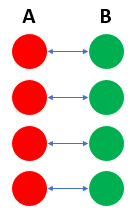Twitter proof: infinite primes
Pt En The proof of this post is a very well known proof on the infinitude of primes. For the proof I am going to rephrase an argument used by Euclid more than $2000$ years ago. Theorem : there are infinitely many primes. Twitter proof : if $\mathcal{P} = \{p_1, \cdots, p_n\}$ is a finite set of primes, then the number $q = p_1\times\cdots\times p_n + 1$ is such that $q \not\in \mathcal{P}$. Either $q$ is prime or $q$ has a prime factor $q'$ that cannot be in $\mathcal{P}$, otherwise $q'$ would have to divide $1$. Hence, no finite set $\mathcal{P}$ can contain all primes. A prova deste post é uma prova conhecida da infinitude dos números primos. Para esta prova vou adaptar ligeiramente o argumento usado por Euclides há mais de $2000$ anos. Teorema : há infinitos números primos. Prova num tweet : se $\mathcal{P} = \{p_1,\cdots,p_n\}$ é um conjunto finito de primos, então o número $q = p_1\times\cdots\times p_n + 1$ é tal que $q \not \in \mathcal{P}$. Ou $q$...

